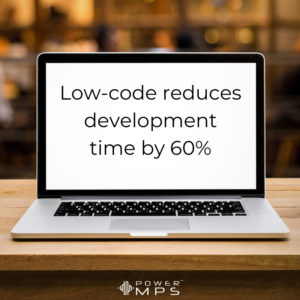Why No-Code / Low-Code is the Future of Software Systems
Core business processes are changing, and they’re shifting towards more end-user-friendly, cost-effective, and efficient systems. ERP Systems is an area that has experienced one of the biggest process changes, and no–code / low-code development is leading that charge toward the future.
Why No-Code / Low-Code is the Future
Low code / no code is a platform that enables businesses to develop software and apps using a visual development approach instead of the traditional, heavy coding, development. People can create applications with having no need for knowledge of programming languages. This user-friendly technology greatly increased adoption of the tech.
Here are three reasons why No-Code / Low-Code is the future of developing:
No-Code / Low-Code Increase Adoption
70% of businesses that attempt to implement new technology or to transform digitally fail. When people fail to adopt new technology, it is too often dismissed as people just not liking change, but the data does not prove that out. Most people and businesses are attempting to change, but they struggle with adoption.
One of the biggest challenges to adopting new tech, be it an accounting ERP system for accounting, sales orders, or a managed print services software, is the ease of use. And, nothing scares off users more than having to know or utilize code. Low Code – No Code eliminates that problem.
No-Code / Low-Code Reduces Cost
The fastest way to increase profitability for any business is usually reducing costs. Going through the challenging financial types of the pandemic and post-pandemic financial world, cost reduction has been necessary for most businesses. Low-Code/No-Code reduces cost. 
Application and software development, implementation, and maintenance is expensive. Low-Code/No-Code eliminates most or all of those expenses. And, No-Code reduces the need for the expense of additional developers. Plus, it limits errors, reducing any further developer maintenance costs.
Additionally, the time to develop low-code/no-code is 60% quicker than traditional development. With developing or selecting software, and implementing it, being long process, low-code/no-code speeding up the process will save time. And, since time is money, reducing all of that time saves money.
There is one more cost-related benefit to low-code/no-code, and that is that is not only reduces costs but it controls costs going forward. Traditional development and maintenance often has unexpected costs. However, with low-code/no-code, especially with software automation, organizations are in control of their costs, and the costs are typically transparent.
No-Code / Low-Code Increases Efficiency
Perhaps the biggest benefit of utilizing low-code / no-code is that it increases the overall efficiency of a company. Part of the increase in efficiency is because of the things that we have already mentioned. When time is saved, money is saved, and the new tech is adopted quickly and utilized, the efficiency of an organization will increase.
Additionally, company efficiency is boosted by the enhanced flexibility of low-code/no-code. Customization is much easier, and the platforms are flexible to be adapted to your specific needs, without the need of the long process and cost of traditional development.
In addition to increased flexibility, No-Code / Low-Code development platforms allow for a much more streamlined process, which makes managing all resources and capital much easier.
Lastly, low-code / no-code development platforms also improve productivity by freeing up developers to focus on more valuable tasks, and boost productivity and innovation.
Additional Benefit to No-Code / Low-Code
No-Code / Low-Code will actually increase the overall need for developers and create new opportunities for developers. Yes, the rise of low-code / no-code might reduce the demand for developers experiencing in coding within some businesses, but it has already brought about countless new software development companies, software consultants, and increased the overall demand for developers.
And, the even better news, low-code / no-code might help bridge the digital skills gap
By 2026, over 7 billion people will have or have access to smartphones. This greatly increases the demand for software developers. In fact, it is estimated that by 2030, we will have a global shortage of software developers of over 85 billion. There simply aren’t enough skilled developers in the world to meet the increasing demand.
However, 70% of new developers with no experience learn to build applications with low-code within one month or less, and 28% learn in less than two weeks. With low-code, we will be able to start to decrease the global developer shortage and help tackle the digital skills gap.
TheNo-Code / Low-Code Future is Now
The reality is, we are already well within the period of time when businesses are shifting to low-code development platforms. In fact, by 2024, low-code and no-code will make up over 65% of all development. And, many estimates have that 65% benchmark being reached much sooner because it has been sped up due to the demands of the post-pandemic work and the work-from-home and hybrid shift in the workplace.
The low-code development market exceeded $21 billion in 2022, and it will continue to rise. Yes, there are some limitations to low-code / no-code, such as limited customization, security risks, and limited scaling, but advances in technology are helping to solve those limitation concerns. And, with our current economic times limiting budgets and requiring quicker turnarounds, No-Code / Low-Code is what is needed for businesses.


Comments (0)